For the 1932 Olympics at Los Angeles the Cross Country was held on the William P. "Billy" Bell designed and managed Sunset Fields Public Golf Courses at Crenshaw and Martin Luther King blvd. @iocmedia #LAGolfHistory #SouthernCaliforniaGolf pic.twitter.com/C25ZXuVH07
— Golf Historical Society (@GolfHistorical) May 7, 2023
Category: California Golf History
The Herbert Warren Wind Golf Book Award for 2021
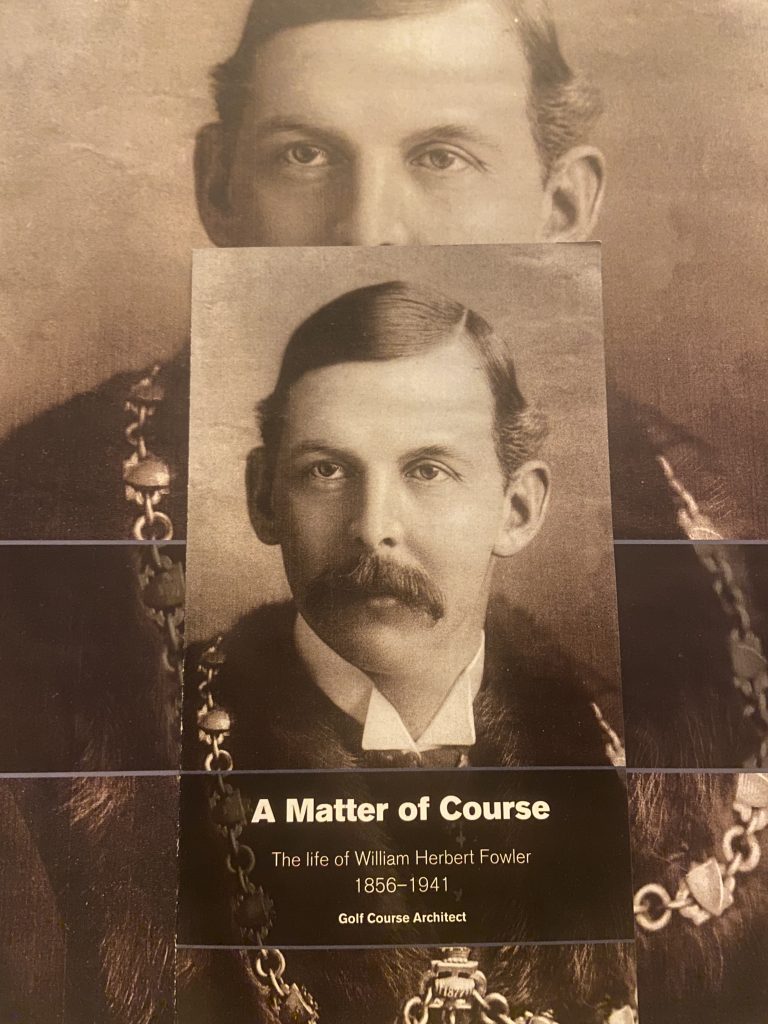
Congratulations to Derek Markham for winning the U.S.G.A.’s Herbert Warren Wind Book Award for 2021, for “A Matter of Course: The Life of William Herbert Fowler, 1856-1941, Golf Course Architect”!
My contribution to Fowler’s American Adventures came with much assistance from Philip Truett, who co-published the book with Derek!
The Virginia Country Club’s 100th Anniversary at Los Cerritos!

At Rancho Los Cerritos in Long Beach, on September 1, 1921, a day after the new Hunt & Burns clubhouse was dedicated, the new William Watson designed grass-green golf course of the Virginia Country Club opened to its members.
The club had voted to move from Los Alamitos after ten years, leaving their old Arthur Rigby designed links to become Recreation Park municipal golf course.
The Virginia Country Club of Long Beach incorporated in 1909, and like many California golf clubs, was started by land and hotel owners working together to bring people to their cities and resorts. It was Hotel Virginia manager and avid golfer Carl Stanley who led the committee to find a location for a country club and golf links. The committee chose Los Alamitos due to its large lake and forest of Blue Gum trees, plus its location on the electric train line to Huntington Beach.

After Long Beach, Stanley become the long time manager of the Hotel Del Monte, where he stayed in charge from 1915-1941, fathering the Pebble Beach golf links and other Del Monte Properties golf courses.
©2021 jib jones – golfhistoricalsociety
The Opening of Los Angeles Country Club’s W. Herbert Fowler designed North course in 1921
It was with great anticipation that Los Angeles Country Club’s new North course at Beverly officially opened to members on Wednesday, August 10, 1921, making LA CC the first club in California to have adjoining eighteen hole golf courses. The new course had been “thrown open for practice,” in early June, and members had declared it couldn’t be improved.
The big event of the opening day was an exhibition match between green committee man, George C. Thomas Jr., who laid out the W. Herbert Fowler designed eighteen hole golf course, paired with Miss Doreen Kavanagh, Southern California and State amateur champion, playing against Southern California amateur champion and general manager of Catalina Island Company, Everett Seaver, and Northern California women’s champion, Miss Margaret Cameron.
Thomas and Kavanagh defeated Cameron and Seaver by a score of 3 up and 3 to play. Broken down, Thomas beat Seaver, 1 up, and Kavanagh beat Cameron 3 and 2, in what was called a keen match.
After the exhibition there was a dinner and dancing for 400. The day’s events were filmed.
The club’s Superintendent of Grounds for many years was Charles Cavanaugh. He and his crew did an amazing job building and rebuilding holes for both new golf courses in under a year, all while keeping 18 holes open for competition.
Alex J. Morrison, of Los Angeles Municipal, Catalina Island, and vaudeville, who had started at LACC as a caddy at Pico and Western, was appointed professional in July of 1921, replacing golf legend John Duncan Dunn and his team of British golfers. Morrison’s assistants were Vic Dalberto and Harry McNamara. Alex was soon back on stage and replaced at LACC by Alex Duncan, brother of earlier LACC professional James Duncan, and British golf legend George Duncan.
There was so much praise heaped on George C. Thomas Jr., for laying out the North course, that Herbert Fowler got more than a bit lost in the press releases. Fowler was a very busy man that summer, having completed the South and North courses for LA CC, the Ambassador-Rancho Golf Club, redesigns of Del Monte #1 and #2 (Pebble Beach), and designs for the Presidio, Olympic Club, Burlingame, Crystal Springs and others.
The North course still has 12-13 original holes laid out by Fowler that were reconstructed by William P. Bell to George C. Thomas Jr.’s redesign in 1928, when they also added five new holes. The 2010 Gil Hanse restoration was to the 1928 Fowler-Thomas-Bell version of the North, plus rebuilding the old Fowler par three 17th (replaced in 1928), which is now an extra hole.
On August 10, 2021, we can celebrate the design brilliance of Herbert Fowler, George C. Thomas Jr., and William P. Bell, along with the restoration by Gil Hanse. Happy 100th Birthday LA CC North!
©2021 J.I.B. Jones -golfhistoricalsociety.org
England, Canada, and California’s Willie Lock – Through The Green
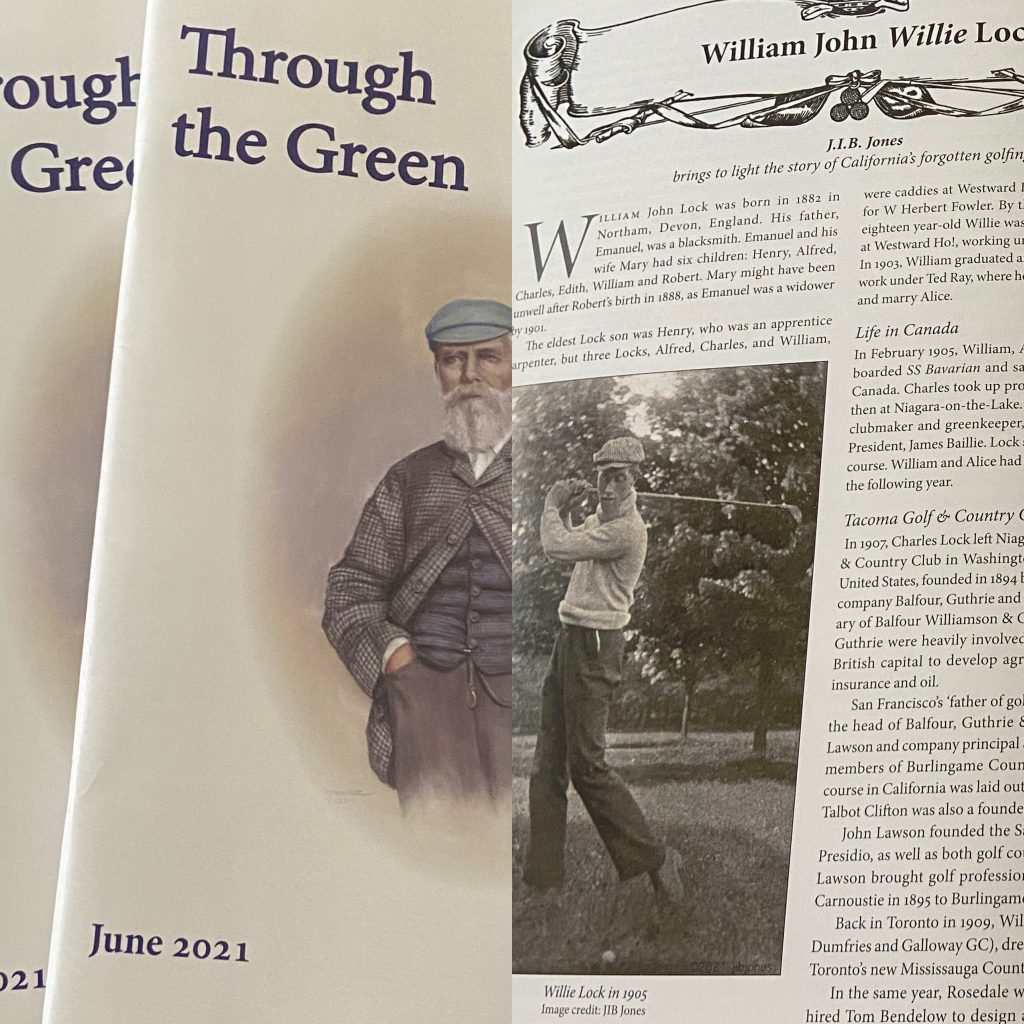
It is a wonderful honour for me to have my short story of legendary English golf professional Willie Lock published in the British Golf Collectors Society‘s June edition of Through The Green! And for those who are still patently unaware, his name was LOCK.
While researching English golf course architect William Herbert Fowler’s work in California in the 1920’s for Derek Markham’s A Matter of Course, Willie’s name kept coming up, forcing me to investigate a lost legend in English, Canadian, and Californian golf history. Willie had caddied for Fowler at Royal Devon before starting work as an apprentice under club making legend Charles Gibson.
From Royal Devon to Ganton, to Rosedale in Toronto, Riverside (CA), Los Angeles and San Francisco, Willie Lock was instrumental in raising the art of golf professional to a new level. Lock was a master club maker, having made Ted Ray’s famous driver when he was at Ganton. One of Willie’s most famous golf courses – San Francisco Golf & Country Club – is credited to Albert Tillinghast. According to his peers and golf writers of the day, Tillinghast blessed Lock’s plans when he visited the site when the course was already two years into construction.
Willie Lock was also credited with initiating the shift of golf tournaments to Red Cross benefits during World War I, as well as serving as President of the Northern California Professional Golfers Association.
©2021 golfhistoricalsociety – JIB JONES.
Tiger Pines – the 2008 U.S. Open
by J.I.B. Jones
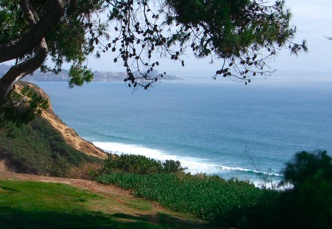
In mid-June 2008 I took the Pacific Surfliner train along the coast from Los Angeles to Rancho Santa Fe and thence to Torrey Pines for the 108th U.S. Open golf championship. I was a guest of the U.S.G.A. after having helped Pete Georgiady research for his article about public golf on the west coast in the official 2008 U.S. Open Program. Pete’s story opened with my story of baseball legend Babe Ruth signing his Yankee contract at Griffith Park’s original 18-hole Municipal Links in January 1920. Griffith Park later hosted the Los Angeles Open from 1937-1939 on both George C. Thomas Jr., designed courses. They were remodeled and toughened up in the 1930’s by Billy Bell and Bill Johnson with Works Progress Administration funding in anticipation.
Los Angeles’s other municipal gem is the Rancho golf course where the Open was also held from 1955-1972, and in 1983 when the Riviera Country Club held the P.G.A. championship. Rancho’s most memorable moment, as chosen by the editors, was Arnold Palmer’s 12 during the first round of the 1961 L.A. Open. Nevertheless, I’m more than pleased to have my name in print as the Rancho Park Golf Club historian. Thanks to everybody in the club for being a part of it, and to L.A.’s Recreation & Parks Golf Division for recommending me to Pete!
As I was lucky enough to be staying in Rancho Santa Fe with a great friend, I was able to take the volunteer shuttle from the polo grounds to Torrey Pines all week with no hassle. The U.S.G.A.’s organization was spectacular, and no matter what the armchair golf architects think about Torrey Pines’ value as a golf course, Riviera could never host a US Open without a second course for practice and staging and large crowds of spectators. Well, I guess they could if they closed Brentwood, and maybe Bel-Air, and filled them with tents, and shuttled people by helicopter like they do at Grand Prix races!
Unfortunately, the U.S.G.A. didn’t have time to do any historical research on Torrey Pines. In fact, in their display of future US Open venues — in the American Express tent — they wrongly credited Chandler Egan with changing the 18th at Pebble Beach into a par 5. We at Rancho, and Neal Hotelling (the official historian of Pebble Beach), know that it was LACC and Rancho’s own W. Herbert Fowler who made the changes in 1921, the same year he finished designing the original Rancho-Ambassador course, and the Los Angeles Country Club’s North and South courses.
As is my custom, I told everyone that I met about Torrey’s history, even though they were mostly interested in a certain golfer from Cypress, California…
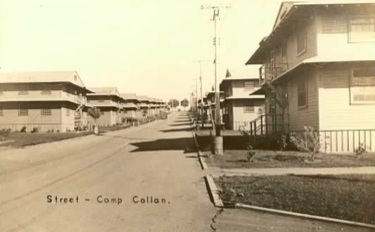
Camp Callan – Torrey Pines South during WW II
For the record, Torrey Pines was given to San Diego in 1908 by Ellen Scripps, the most amazing philanthropist California has ever known. Miss Scripps, along with her sister Virginia, bought every acre of Torrey Pines to stop development, and then donated it to the City of San Diego to be protected and used as a public park. During World War II it became Camp Callan, the Coast Artillery Corps base, then a Sports Car Club of America race track, and then finally the Torrey Pines golf courses.
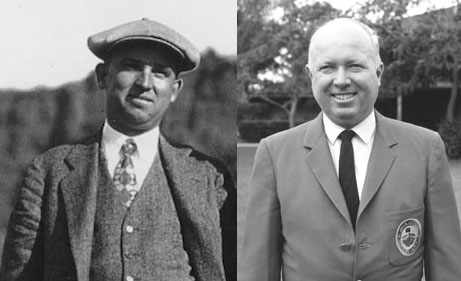
Billy Bell and his son Billy Jr.
William P. “Billy” Bell, who designed, co-designed, or constructed the majority of the great Southern California golden era golf courses before his untimely death from a heart attack in 1953, had the original vision for Torrey Pines. His equally prolific and brilliant son William F. Bell (Billy Jr.) made his father’s vision a reality by completing the designs in 1955 when he began construction of the golf courses.
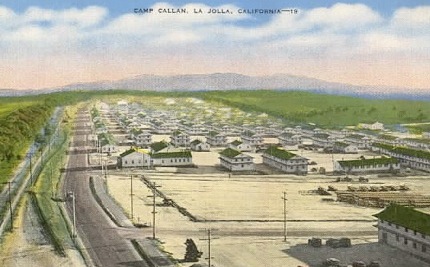
Camp Callan postcard – Torrey Pines South during WW II
Billy Jr. shaped the mostly flat landscape into the rolling land of the Torrey Pines we know today by using the many acres of asphalt roads, parade grounds, and even the foundations of the camp buildings, piling the rubble to shape the courses. Truly a pair of genius’ at work!
Torrey Pines South course opened in June 1957 with an exhibition that included 1934 Rancho golf course professional Ralph Guldahl, winner of the 1937-38 U.S. Open and the 1939 Masters.
In 1972 golf course architects David Rainville and Billy Casper did a major remodeling job which included recontouring the greens. More recently, Rees Jones improved the layout tenfold in preparation for the 2008 US Open. The local club golfers I met over the week were amazed at how beautiful Rees had made their golf course.
Maybe we can use Hillcrest for the extra tents and host the US Open in 2024 at Rancho Park!
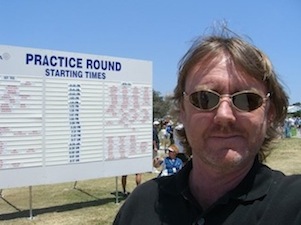
Jones during U.S. Open practice at Torrey Pines
Back to the 108th US Open.
The rough during the practice rounds was all anybody needed to see to know that hitting fairways was going to be the name of the game at this Open. Unlike the Masters, getting up and down wasn’t the hard part. Narrow fairways made it paramount to be in the fairway. Even the short rough made hitting the green unlikely and a bogey likely. Many players also seemed to be caught off guard by the fluffy sand traps and the slowness of the greens the first couple of days compared to expectations.
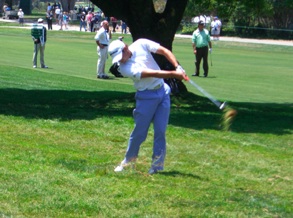
Sergio Garcia didn’t get this one (or the next 2) out of the second cut on 14 on Wednesday.
The U.S.G.A.’s scoring prediction was right on. They got what they wanted and the spectators and TV viewers were treated to some brilliant golf. Even the best drivers of the ball ended up in the rough and paid the price. How Tiger won while missing so many fairways says volumes about the quality of his short game and his superhuman strength from the rough. Even though we always go on about his awe-inspiring swing, he really is also as good as the best putter who has ever lived — and his ‘drive’ to win is unequalled.
There were many highlights of my week, including seeing former S.C.G.A. President Ed Holmes scouting the course for the TV announcers, and meeting up with legendary golf course supervisor Ted Horton (C.G.C.O.A.), Kevin Heaney (S.C.G.A.), Craig Kessler (P.L.G.A.) and U.S.G.A. President Jim Vernon and his assistant Ashleigh on the North Course, away from the action, for a photo shoot celebrating Golf Week in California.
The most impressive feat of the event, without a doubt, were the thousands of volunteers who came from all over America and across the world to work for their clubs and charities, helping to raise millions for their communities. It really is the pinnacle of dedication and charitable giving by the volunteers, and the U.S.G.A. should be praised for using their championships this way.
I was so lucky to have been a part of the 108th US Open. Thank’s Pete and Kevin! I did it wearing my Rancho Park logos in full view on the various shirts and visors I wore all week.
Next up for us in California – Pebble Beach 2010.
All photos and words Copyright 2008-2014 JIB Jones Golf Historical Society
Not to be reprinted without permission.
A Matter of Course – The Life of William Herbert Fowler 1856-1941

A Matter of Course is a new book written by Derek Markham and published by Markham & Truett.
The story of legendary golf course architect William Herbert Fowler. The book is a proper biography of a most interesting life, mostly well lived.
I contributed research to the chapter, “American Adventures,” written about Fowler’s work in California, which included Los Angeles Country Club, Pebble Beach and the Del Monte Hotel courses, the Presidio, Burlingame Country Club, the no longer existing Ambassador/Rancho Golf Club, Olympic Club, Lincoln Park, Sequoyah, Del Paso, Crystal Springs, Menlo C.C., and others!
This is a small print of 650 books that can be ordered by emailing Philip Truett:
philip@truett.co.uk
or ordering online from Browns Books
Only Woman Golf Pro is Pasadenan
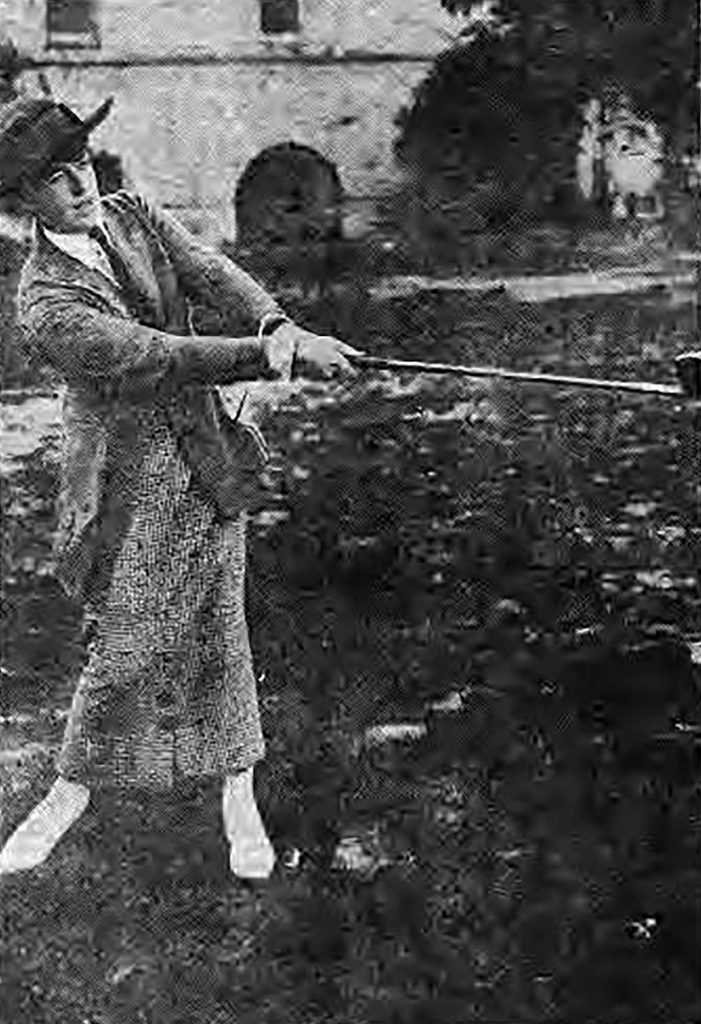
Mrs. Gourlay Dunn-Webb, who bears the unique distinction of being the only woman golf instructor in the country.
From an article published in 1919:
Pasadena has long been noted as being the home of many “best“ and various “onlys,“ but a new distinction has been added in the latter class by the presence here of the only woman golf professional in the country.
She is Mrs. Gourlay Dunn-Webb, is the niece of famous Willy Dunn, and is conducting a series of demonstrations at the Hotel Maryland.
Mrs. Webb comes from a family of noted golfers. Her grandfather and great grandfather on both sides were players and teachers, and her father, the late Thomas Dunn, was acknowledged the greatest teacher of his time. Mrs. Webb‘s mother was the first woman teacher in England, having taught golf in 1875 at the Royal Wimbledon Golf club.
Mrs. Webb was the next women instructor and taught the game at Prince’s Golf club, near London, one of the principal women’s golf clubs in England. Mrs. Webb can drive a ball 250 yards. The average woman’s drive is about 100 yards less.
She has worked out everything to her own satisfaction, dress as well as the method of procedure, playing the game to get the best results.
“It is simply wonderful,“ said Mrs. Webb, when I asked to give her opinion of the value of the game as an exercise and amusement. “It exercises every muscle in the body, even the toes, the head, the hands. It is the unique exercise. Golf is all a question of balance and poise, it creates a control of the body that no other game can give, and I’d say it is particularly beneficial for women.“
Mrs. Webb herself in action, with rare poise and control, is sufficient proof of the statement.
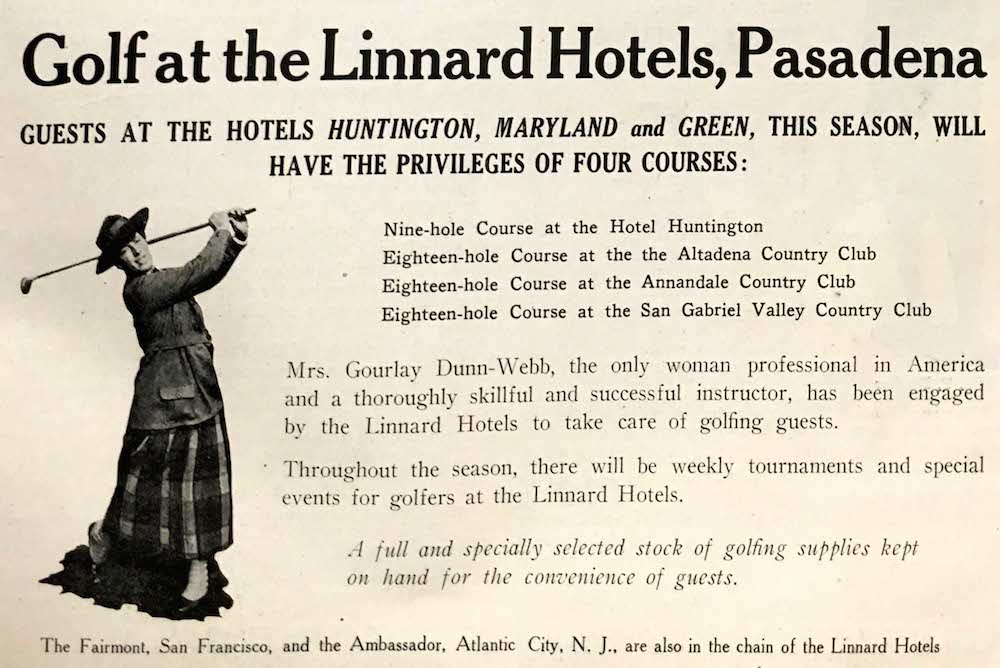
Aside from golf-instruction, this week Mrs. Webb is conducting the hiking expeditions from the Hotel Maryland.
©2021 jib jones – Golf Historical Society
Norman Macbeth Jr., ref. note
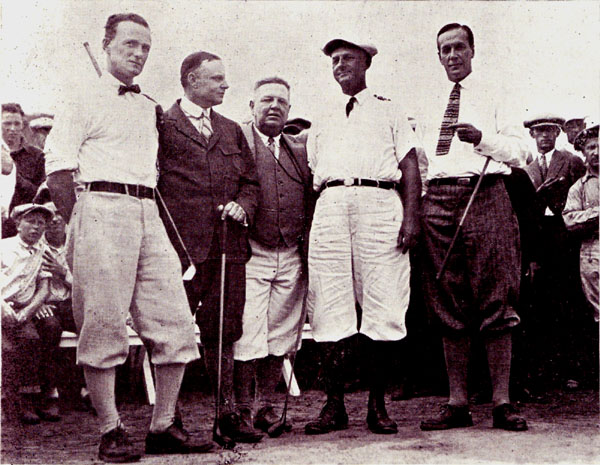
Norman Macbeth Jr., was born in Bolton, England in 1879, and grew up playing at Royal Lytham & St Annes golf club where he won the club championship three times while still in school. After an engineering apprenticeship in India with his father’s company he emigrated to Indianapolis, Indiana, in 1903.
Norman married American Lucia Holliday in 1907, and they moved to Pittsburgh where Macbeth played on the Oakmont Golf Club Leslie Cup team with W.C. Fownes Jr., and on the 1909 Pennsylvania State golf team with Albert Tillinghast.
#1 son was John Holliday Macbeth born in 1908. He drowned in 1919 while Norman was in France working for the Red Cross during WW I.
The Macbeth’s moved to Los Angeles in 1910, with Norman working for the Riverside Portland Cement company. The company supplied cement for the Los Angeles Aqueduct and half the roads that we still drive on in the 21st century.
#2 son was Norman Macbeth III or Jr., born in Los Angeles in 1910. He was also a golf champion and lived until 1989.
Norman joined the Los Angeles Country Club and won numerous amateur golf titles over the next several years.
#3 son was Alexander born in 1915 and died in May 1920. Cause unknown.
Macbeth volunteered for the Red Cross in France, where he drove an ambulance, and managed to play at least one round of golf!
He returned to Los Angeles in August 1919, and was soon elected chairman of the Green committee creating the new Wilshire Country Club golf course in Hancock Park, which became his non-working life’s passion.
Norman was also playing a full schedule of club tournaments at Los Angeles Country Club where noted golf architect John Duncan Dunn was professional and George C. Thomas Jr., and Herbert Fowler were making history designing and building the new North and South courses.
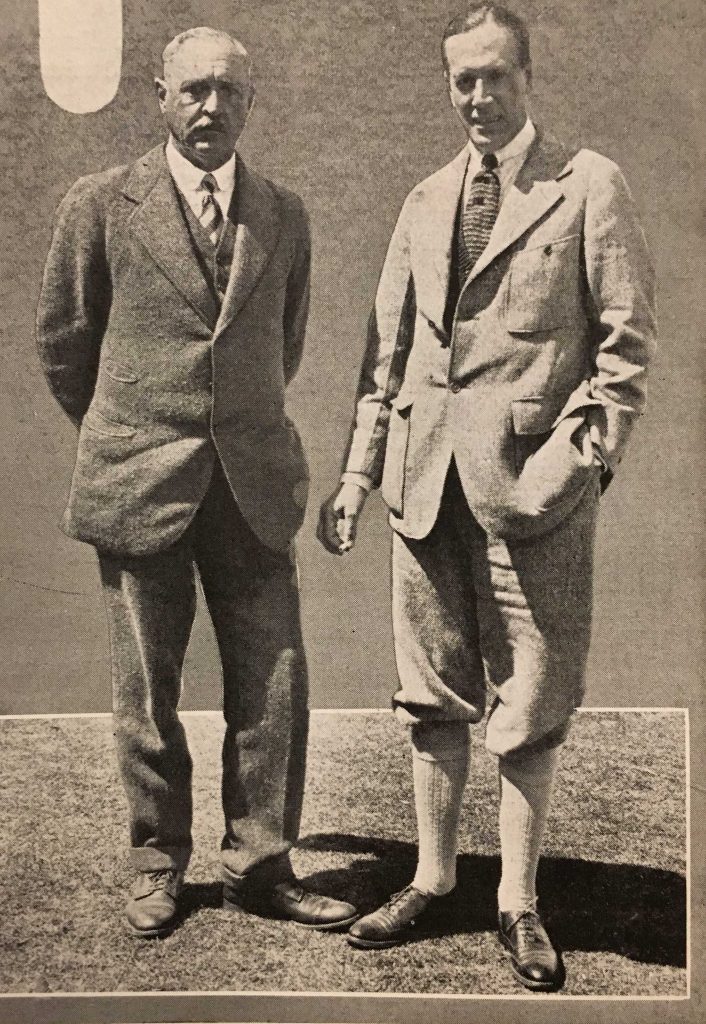
Wilshire Country Club green committee.
The new Wilshire Country Club course was completed and open for member play in December 1920. Macbeth led the club team and green committee and was elected to the USGA Green Section. He was also a member of the Los Angeles Traffic Commission.
Norman and Lucia had an uncontested divorce in 1928.
In 1934 Norman married Lucille Chandler, ex-wife of Wilshire CC founder Raymond Stephens. They were parents to Norman Jr., and Lucille’s son and daughter.
At the time of Norman’s death in 1940, he also left two brothers and five sisters in England.
J.I.B. Jones – January 2021.
©2021 golfhistoricalsociety.org/jibjones
Rancho Golf Course – July 17, 1949
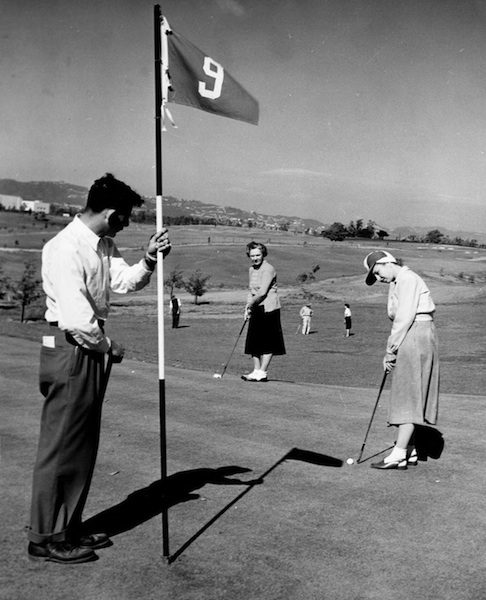
After the Bob Hope Exhibition on July 3, followed by the United States Golf Association Public Links championship, the Rancho golf course opened to the Public on July 17, 1949. Greens fees were $1 for 18 holes!
The Los Angeles Times reported that,
“A capacity play of 400 golfers crowded the new Rancho municipal course yesterday on the first day of public use of the city’s latest 18-hole links.”
“From 4:40 a.m., when the clubhouse doors were open and several score early waitees headed for the starter’s window, until 6 o’clock when the place was jumping. By 7 a.m. a four-hour wait was needed to get a starting time at the first tee.”
“Weekday play at Rancho will start at 6 a.m.”
©2019 golfhistoricalsociety and jibjones All Rights Reserved.
